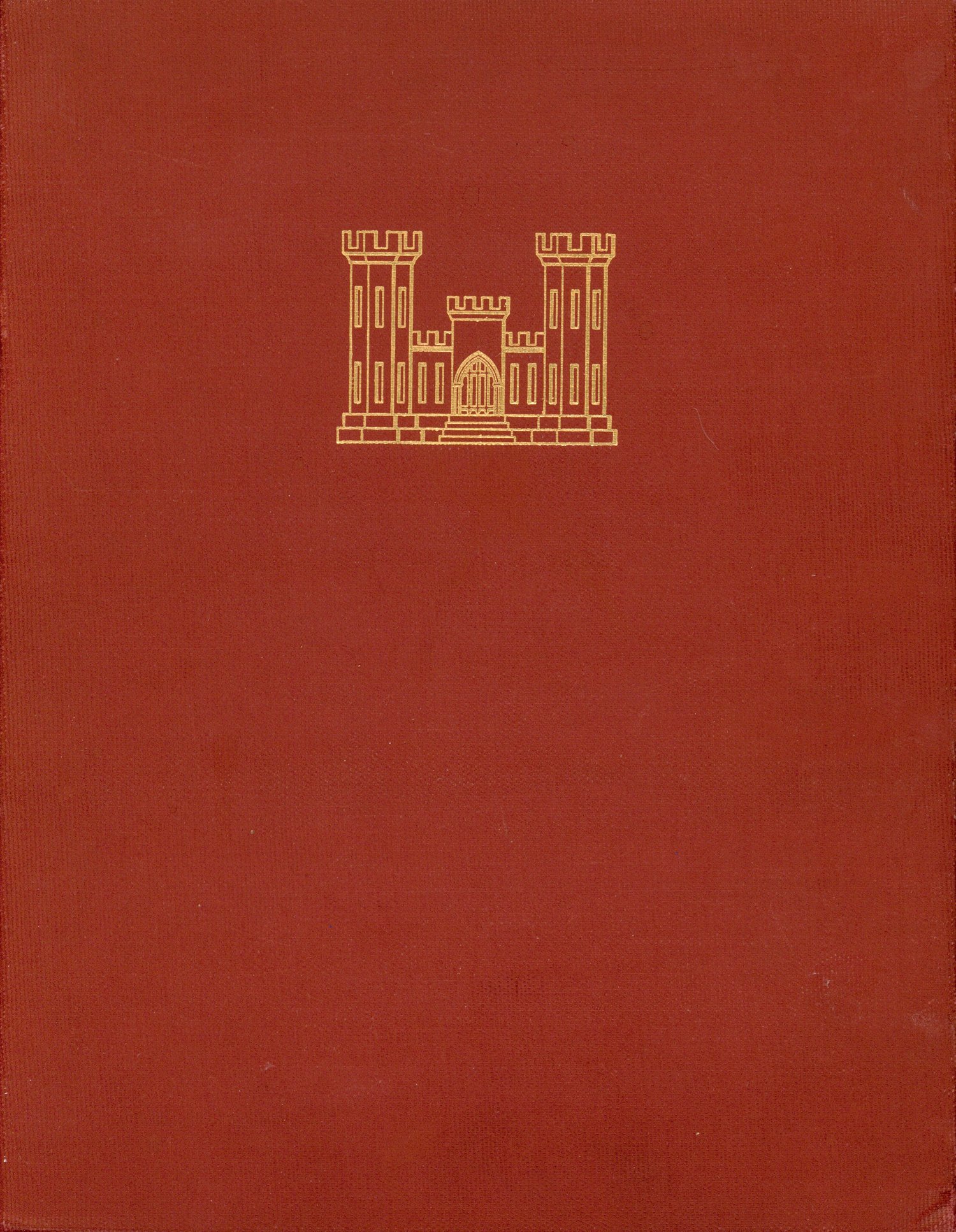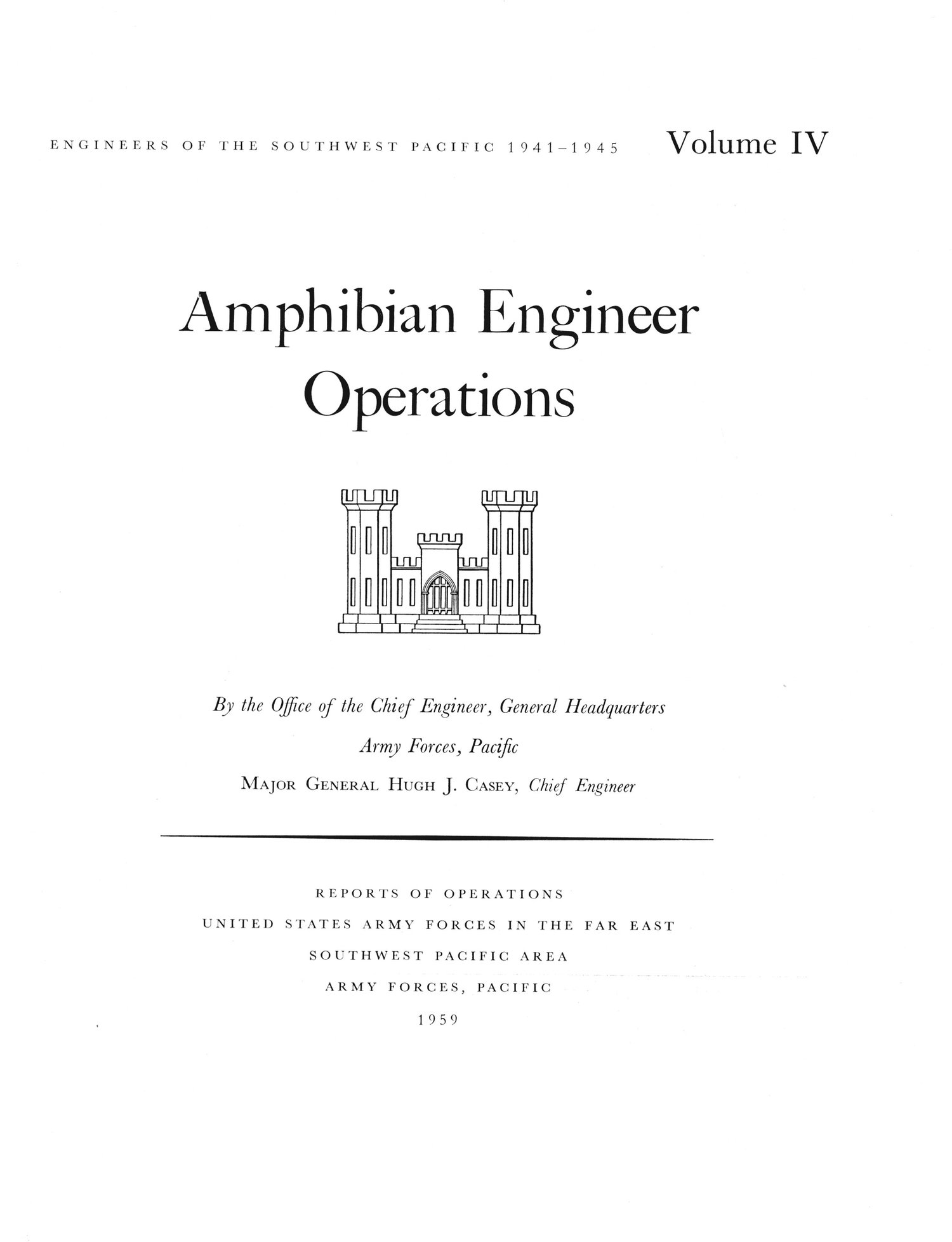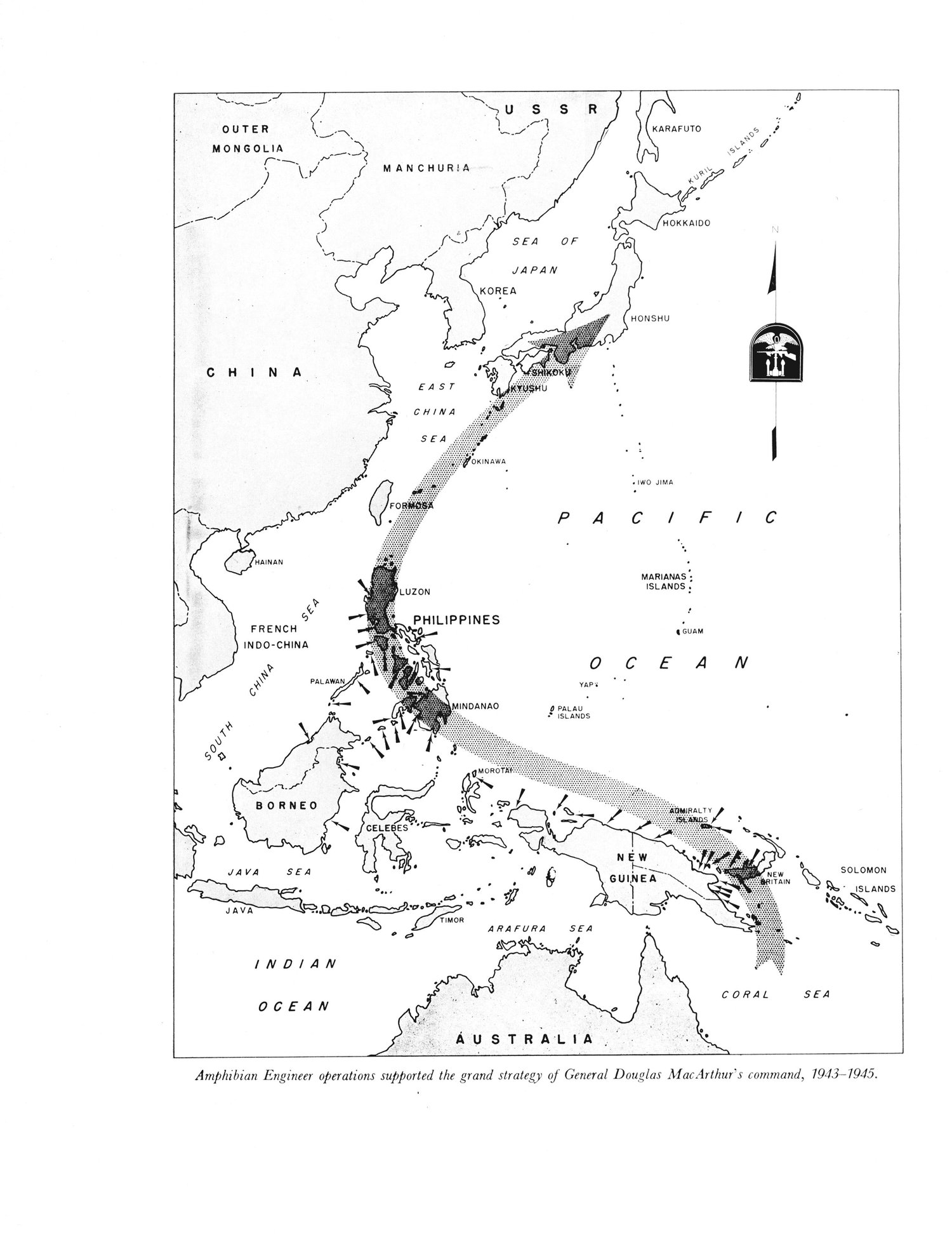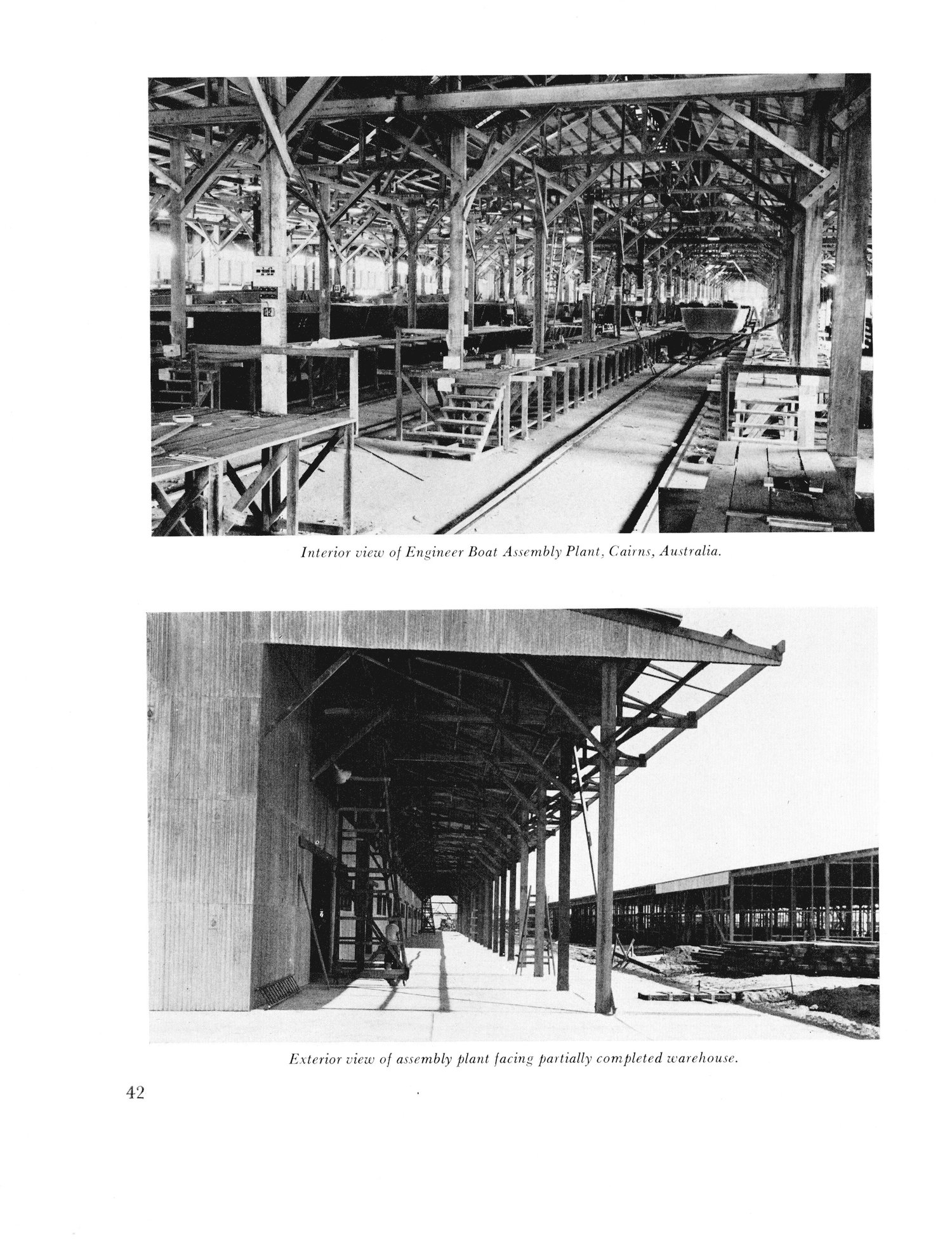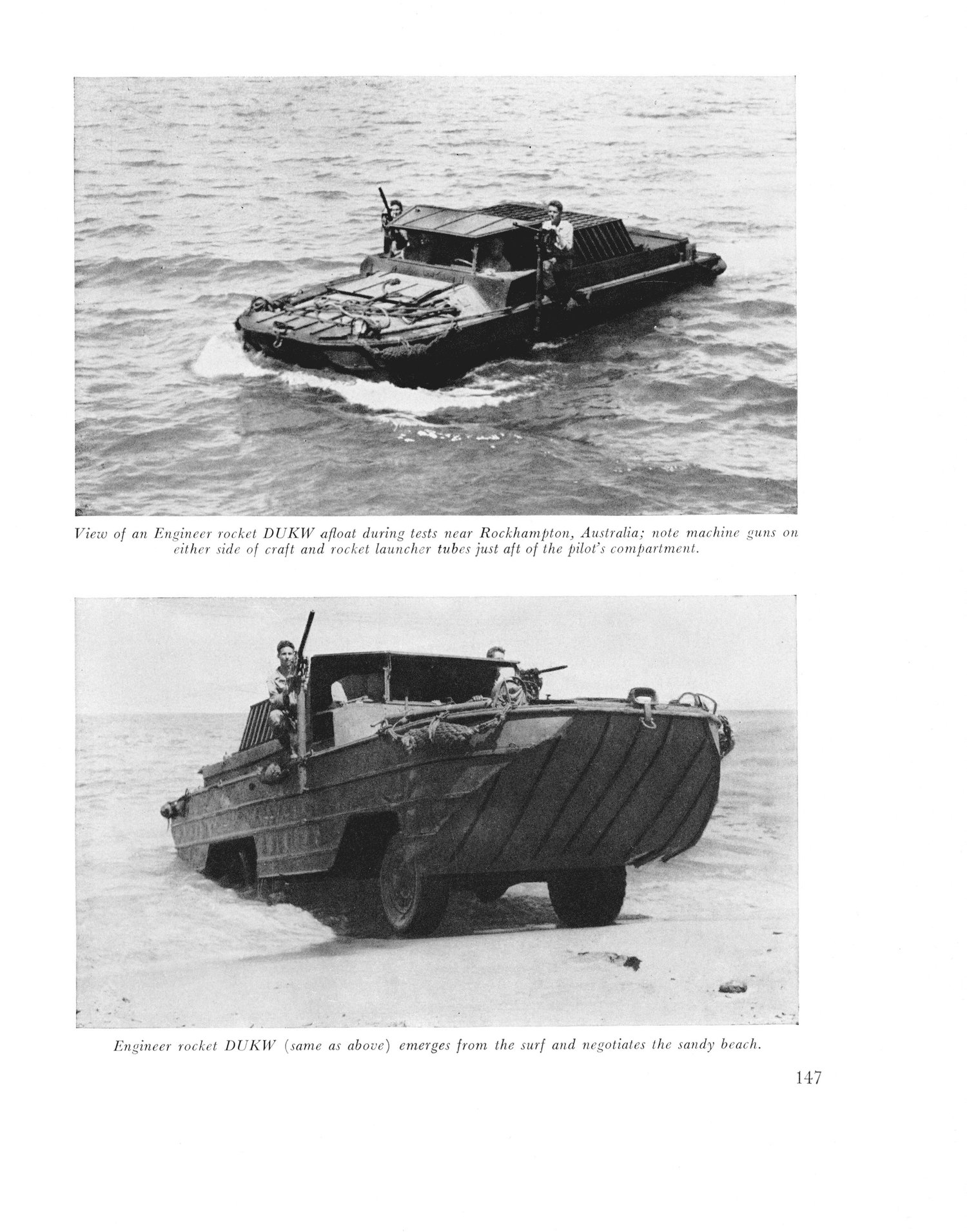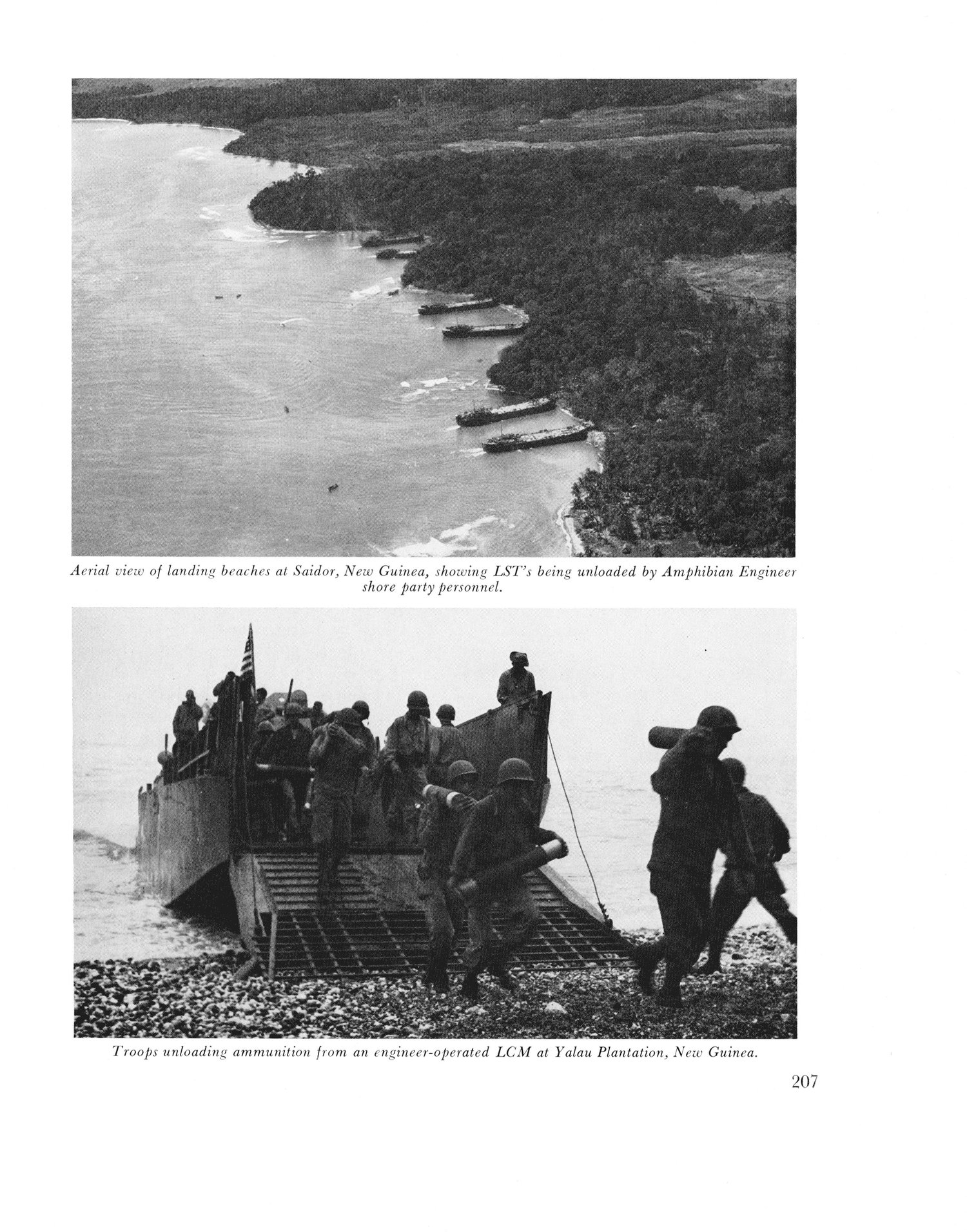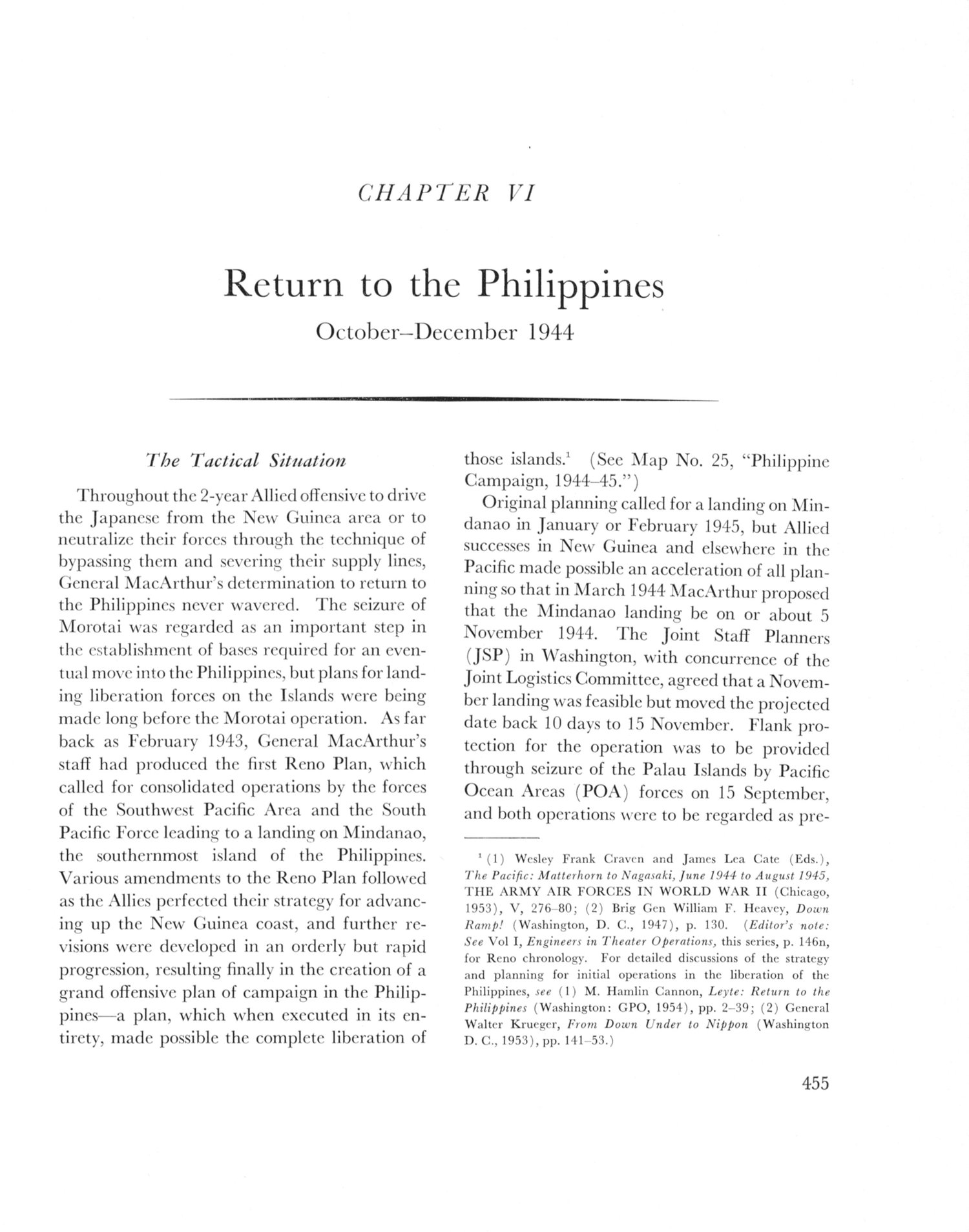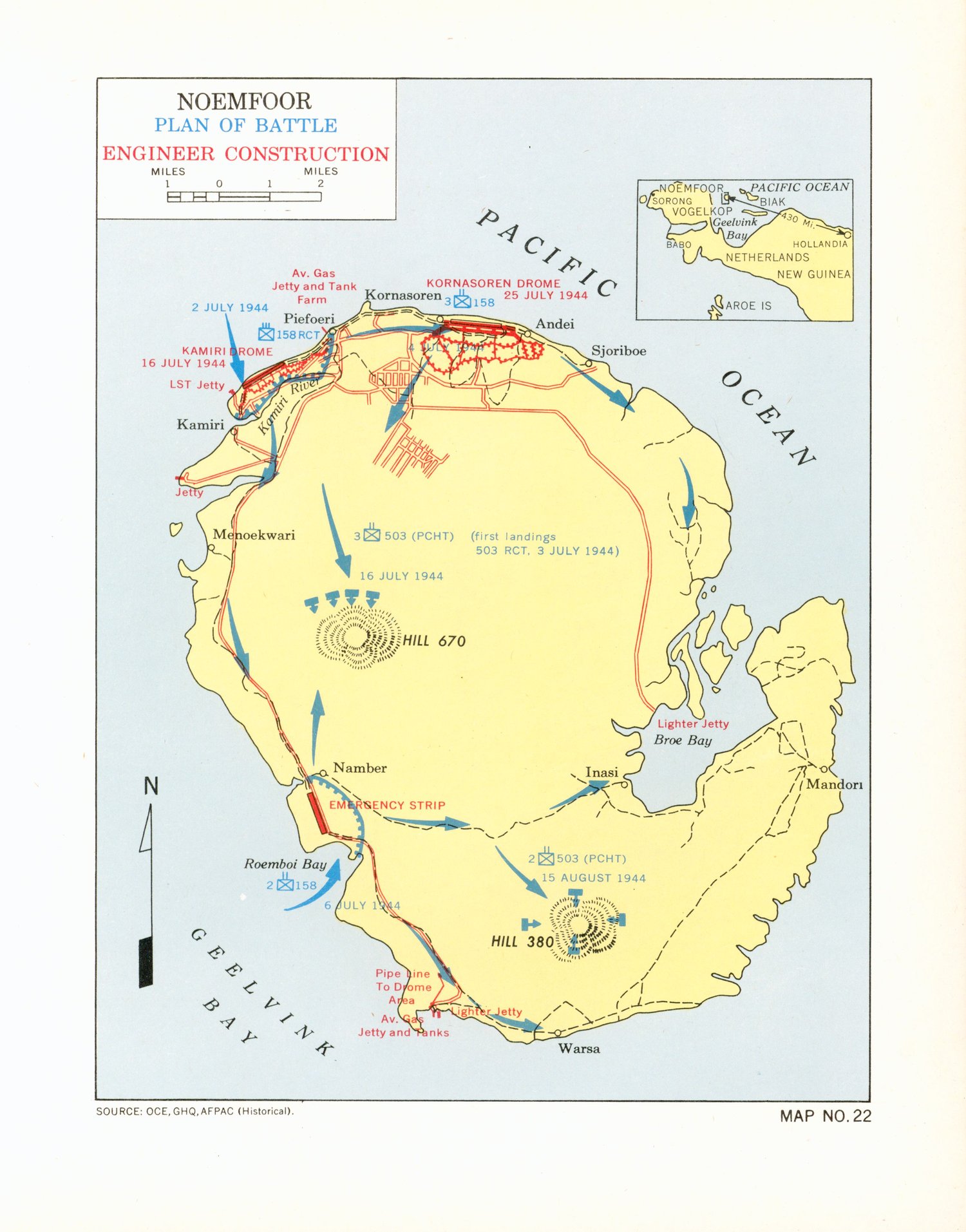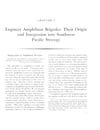Amphibian Engineer Operations: Engineers of the Southwest Pacific 1941-1945 Volume IV
Amphibian Engineer Operations
Engineers of the Southwest Pacific 1941-1945 Volume IV
Reports of Operations, United States Army Forces in the Far East, Southwest Pacific Area, Army Forces, Pacific, 1959
by the Office of the Chief Engineer, General Headquarters Army Forces, Pacific Major General Hugh J. Casey, Chief Engineer
USGPO, Washington, D.C., 1959
FOREWORD
Amphibian Engineer Operations introduces a new and little-known type of Engineer — a soldier-seaman. Organized by the Corps of Engineers into Engineer Special Brigades, these specialists in invasion played a vital role in nearly 150 major and minor landing operations in the Southwest Pacific where amphibious warfare was the only feasible strategic method for seizing advance bases in order to extend Allied air, ground, and naval operations. These Engineers were recruited initially from among boat builders, small boat operators, marine enginemen, and others familiar with the sea, as well as landlubbers from all branches of military and civilian life. In actual operations afloat and ashore the Amphibian Engineers, in accord with their motto, “Put ’Em Across” the enemy-defended and reef-barricaded beaches of widely scattered objective areas in the Southwest Pacific.
To the Amphibian Engineers, intervening expanses of water were no obstacles, but instead were accepted avenues of approach. Before the establishment of Allied air superiority, engineer boat crews moved their craft under their own power into sea lanes originally considered too dangerous for large ships; often, with little or no air cover, they landed assault forces on enemy-held shores. Transporting critically needed supplies, ammunition, and personnel, the Amphibian Engineers manned not only their boats, but machine guns and rocket launchers with telling effect, as they subsequently maintained a lifeline of supply to the ground forces. By exploiting coastal and inland waterways in the forward objective areas, they substituted the medium of overwater resupply and evacuation for the overland transport which was impossible through the tangled jungles and trackless swamps of the Southwest Pacific.
From the day the Amphibian Engineers bucked a blinding storm and rode mountainous seas to land at Nassau Bay, New Guinea, through succeeding months and subsequent landings on New Guinea — New Britain — the Admiralties — Morotai — the Philippines — Borneo and into Japan, their versatile and far reaching tactical and logistical support proved indispensable. Yet, as Lieutenant General Robert L. Eichelberger remarked, “. . . their importance to the winning of the war in the Pacific and their solid exploits under difficulties have been insufficiently heralded.”
Even if the swiftly changing and spectacular events of total war provided little current publicity for these Amphibian Engineers, they never upped ramp without fixing their position permanently in the proud traditions of the Corps of Engineers by their outstanding performance. They emerged from the. rigorous tests of war with considerable tactical significance and left behind a record of an unprecedented Engineer job well done.
PREFACE
This Report of the Chief Engineer, General Headquarters, Army Forces, Pacific, is one of a series of eight volumes covering the activities of the Corps of Engineers in the Southwest Pacific during World War IL The series constitutes a detailed ac-count of the organization, operations, and accomplishments of Engineer components, from the headquarters level down to small units, and has been compiled with the aim of providing valuable reading and research material for higher staff levels of all branches of the military establishment and all officers of the Corps of Engineers, United States Army.
Engineer activities in World War II were so varied in doctrine and procedure in the different parts of the world that it may be many years before any one officer or group of officers can attain a thorough mastery of how the Engineer mission was accomplished in each Theater. These studies are designed to indicate to succeeding generations the character and extent of difficulties encountered in the Southwest Pacific Area (SWPA). Problems of the same type may occur in future conflicts, and their proper solution could spell the difference between victory and defeat. Therefore the entire series is intended to serve not only as an over-all report on military engineering in SWPA during World War II, but also as a source of information for the various training, research, development, and supply agencies operating under the Chief of Engineers. In fact, these reports might well be of primary importance to the General Staff in formulating plans for future operations.
It is believed, then, that the present report will be of value to the Department of Defense in general and to the Corps of Engineers in particular. It should prove of interest to members of the Legislative Branch of the Government whose activities are concerned with the operations of the military departments. The reader interested in making a more detailed study will find in the footnotes an abundance of references to source materials. For the convenience of readers who may not be engineers, every effort has been made to avoid the use of strictly engineer terminology in an endeavor to present clearly and factually all significant detail.
Contents
CHAPTER 1. ENGINEER AMPHIBIAN BRIGADES: THEIR ORIGIN AND INTEGRATION INTO SOUTHWEST PACIFIC STRATEGY.
- Background of Amphibious Warfare
- Basic Principles
- Landing Craft
- Marines’ Technique
- The German Viewpoint
- Progress Report
- British Developments
- Churchill and Roosevelt
- Development of the Engineer Amphibian Mission
- Allied Strategy
- Allied Conferences
- Engineer Assignment
- “Specialists in Invasion”
- 'Braining Mission
- Coordination Problems
- Organizational Structure of the Brigades
- Typical Brigade
- Activation, Training, and Oversea Movement of Brigades
- Training on Cape Cod
- Specialized Training
- Reorganization Plan
- Casey Memorandum
- Boat Assembly Plan
- The 3d and 4th EAB’s
CHAPTER II. AMPHIBIAN ENGINEERS IN AUSTRALIA AND INITIAL EMPLOYMENT IN NEW GUINEA, FEBRUARY-SEPTEMBER 1943.
- Tactical Background
- Arrival of the 2d Engineer Amphibian Brigade in Australia
- Training of the 2d EAB
- Boat Assembly and Procurement
- Rehearsal in Australia
- Reallocation of Amphibian Responsibilities and Brigade Reorganization
- Reorganization of the Brigades
- Final Preparations of the 2d ESB for Combat Operations
- Movement to New Guinea
- Nassau Bay, Tambu Bay, and Salamaua, 29 June—11 September 1943
- The Allied Build-up
- The 542d EBSR Called In
- The Boat Control Plan
- Daylight Boat Missions
- Salamaua Falls
- Lessons Learned
- Lae, 4 September 1943
- Planning for Lae
- Staging and Rehearsal
- General Heavey’s Views
- Final Plans
- Loading and Embarkation
- Landings at Lae
- Developing the Beachhead
- The Second Phase
- Crossing of the Busu
- BoatOperations
- The Fall of Lae
- Lessons Learned
- Finschhajen, 22 September 1943
- Planning for Finschhafen
- Assembly and Departure
- Assault at Finschhafen
- Developing the Beach
- The Japanese Strike
- Final Operations
- Command Functions at the Brigade Headquarters Level
- Appearance of the 3d Engineer Special Brigade in Southwest Pacific Operations
CHAPTER III. SECURING THE VITIAZ AND DAMPIER STRAITS, DECEMBER 1943-MARCH 1944.
- Tactical Background
- Initial Planning for New Britain
- Arawe, 15 December 1943
- The Landings at Arawe
- Patrols and Reconnaissance
- The 3d ESB Arrives
- Lessons Learned
- Cape Gloucester, 26 December 1943
- Planning for Cape Gloucester
- Movement to the Objective
- Green Beach Landing
- Yellow Beach Landings
- Long Island, 26 December 1943
- Talasea, 6 March 1944
- Planning and Staging
- The Landing at Red Beach
- Capture of Talasea and Later Operations
- ESB Support Operations on New Britain
- Saidor, 2 January 1944
- Planning for the Saidor Operation
- The Landing at Saidor
- Development of the Beachhead
- Relief of the 2d ESB Operational Groups
- Arrival of the 533d EBSR
- Yalau Plantation, 5 March 1944, Postscript to DEXTERITY
- Planning for Yalau Plantation
- The Landing at Yalau
- Subsequent Operations at Yalau
CHAPTER IV. ADMIRALTY ISLANDS AND NEW GUINEA, FEBRUARY-APRIL 1944.
- The Admiralties—“Putting the Cork in the Bottle”
- Planning for the Admiralties
- Los Negros Island, 29 February 1944
- Hauwei and Butjo Luo Islands, 11-14 March 1944
- Manus Island, 15 March 1944
- Roundup in the Admiralties, 11 March-18 March 1944
- Hollandia {Humboldt Bay-Tanahmerah Bay) and Aitape, 22 April 1944
- Planning for Hollandia
- Staging Area and Movement Operations
- Tanahmerah Bay, 22 April 1944
- Humboldt Bay, 22 April 1944
- Aitape, 22 April 1944
- Retrospect — The Occupation of Madang, 24 April 1944
CHAPTER V. FINAL TACTICAL OPERATIONS IN NEW GUINEA AND ON MOROTAI OF THE MOLUCCAS, MAY-SEPTEMBER 1944.
- Toem and the Wakde Islands, 17-18 May 1944
- Planning for Wakde
- The Battle for Wakde
- The Drive Toward Maffin
- Biak Island, 27 May 1944
- Planning for Biak
- The Landing at Biak
- The Battle for Biak
- Noemfoor Island, 2 July 1944
- Planning for Noemfoor
- The Landing on Noemfoor
- Final Operations on Noemfoor
- Sansapor, 30 July 1944
- Planning for Sansapor
- The Sansapor Landings
- Final Operations
- Morotai Island, 15 September 1944
- Planning for Morotai
- Rehearsal and Outloading
- Overwater Approach
- Red Beach Landing
- White Beach Landing
- Subsequent Beach Operations
- Task Group 403
- Final Operations on Morotai
- Proposals for Reorganizing Engineer Special Brigades
- Development and Improvements to Amphibian Engineer Equipment
- LCVP versus LCM
- Problems of LCM Assembly
- The LCM(6)
- Appearance of the 4th Engineer Special Brigade in Southwest Pacific Operations
- Operations in Rear Areas
VI. RETURN TO THE PHILIPPINES, OCTOBER -DECEMBER 1944.
- The Tactical Situation
- Leyte, 20 October 1944
- Planning and Staging
- Outloading and Rehearsals
- Movement to the Objective Area
- Green Beach Landings
- Approach to the Northern Beaches
- Red Beach Landing
- White Beach Landing
- Summary of Assault Phase Operations
- Consolidation Phase at Leyte Beaches
- 2d ESB Statistics and Logistics, 1944
- Final Operations on Leyte
- Ormoc, 7 December 1944
- Palompon, 25 December 1944
- Mindoro, 15 December 1944
- Planning for Mindoro
- Loading and Movement
- The Landings at Mindoro
- Off-loading in Record Time
- The Amphibian Engineers Operate a Railroad
- Operations Ashore
- The LT plus 7 Convoy
- The Japanese Navy Strikes
- The U plus 15 Supply Echelon
- Operations under Eighth Army
- Final Operations on Mindoro
VII. THE PHILIPPINES LIBERATED. JANUARY JULY 1945.
- Luzon—The Tactical Situation
- Lingayen Gulf, 9 January 1945
- Amphibian Engineer Planning and Staging
- Approach to Lingayen Gulf
- The S Day Landings
- Beachhead Development, S plus 1
- Red Beach, S plus 2
- Operations Subsequent to S plus 2
- Support Operations at Lingayen Gulf
- Logistical Summary of Beach Operations
- Some Conclusions and Lessons Learned
- La PazSubic Bay, 29 January 1945
- The Landings near La Paz
- The Move to Subic Bay
- Nasugbu, 31 January 1945
- Mariveles—Corregidor, 15-16 February 1945
- The Landing at Mariveles
- The Corregidor Operation
- Manila Harbor Opened
- Caballo, El Fraile (Fort Drum), and Carabao Islands, 21 March-16 April 1945
- Caballo Island
- El Eraile Island (Fort Drum)
- Carabao Island
- 4th ESB at Manila
- Rehabilitation at Manila
- Secondary ESB Operations on Luzon
- Coastal Missions
- Construction at San Fernando
- Aparri
- Laguna de Bay
- Batangas
- Accolade by General MacArthur
- Final Operations on Luzon: Bicol Peninsula and Dingalan Bay, 1 April-31 July 1945
- Legaspi
- Pasacao
- Dingalan Bay
- Camotes Islands and Masbate, 15-18 January and 3 April 1945
- Ponson Island
- Poro Island
- Masbate Island
- Northern Samar and Biri Island, 19-20 February 1945
- Dalupiri Island
- Capul Island
- Macarite Island and Catarman, Samar
- Biri Island
- Palawan, 28 February 1945
- Planning and Staging
- Landings on Palawan
- Off-loading at Puerto Princesa
- Busuanga Island
- Final Operations
- Panay and Negros, 18 March-26 April 1945
- Panay
- Negros
- Cebu and Bohol, 26 March- 11 April 1945
- Cebu
- Bohol
- Mindanao and the Sulu Islands, 10 March-12 July 1945
- Zamboanga
- Basilan Island
- Tawitawi Islands
- Jolo Island
- Malabang and Parang
- Mindanao River Operations
- Davao Gulf
- Macajalar Bay
- Agusan River
- Sarangani Bay
VIII. FAR EAST VICTORY: AMPHIBIAN ENGINEERS IN BORNEO, OKINAWA, JAPAN, AND KOREA, APRIL-DECEMBER 1945.
- The Liberation of Borneo
- Tarakan, 1 May 1945
- Brunei Bay, 10 June 1945
- Balikpapan, 1 July 1945
- The 1st Engineer Special Brigade at Okinawa, 1 April-31 May 1945
- Planning for Okinawa
- Landings on Okinawa
- Operational Problems
- The Engineer Special Brigades in Japan and Korea
- The ESB Plan for Japan
- Arrival in Japan and Korea
- Accomplishments Reviewed
- General Casey’s Summation
APPENDIX I. GENERAL CHARACTERISTICS OF LANDING CRAFT, LANDING SHIPS, AND AMPHIBIOUS VEHICLES, 1941-1945
APPENDIX II. RECOMMENDATIONS CONCERNING MOVEMENT OF ENGINEER
AMPHIBIAN UNITS TO THE SOUTHWEST PACIFIC
APPENDIX III. ASSEMBLY OF LANDING CRAFT IN A THEATER OF OPERATIONS
APPENDIX IV. OPERATIONS OF ESB BOAT POOL IN TACTICAL AND RESUPPLY
MISSIONS
APPENDIX V. THE 2d ENGINEER SPECIAL BRIGADE SUPPORT BATTERY
APPENDIX VI. AN AMPHIBIAN ENGINEER RECONNAISSANCE ON NEW BRITAIN
CHRONOLOGY (with Map)
GLOSSARY
GUIDE TO FOOTNOTES
INDEX
842 pages
40 maps
8 charts
3 tables
137 photos/illustrations

